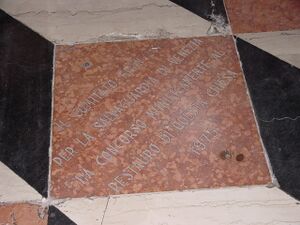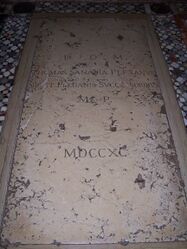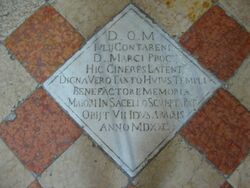Church Floor Artifacts
An artifact is anything that was inlaided into the floor after construction. Typically, they contain inscriptions or are a different shape or material than the surrounding floor. Venetian church floor artifacts can be broken down into two categories, tombs and plaques. One of the reasons visitors choose to enter the churches of Venice is to view the artwork they contain. The artwork is not limited to sculptures and paintings displayed at eye level on the walls of building or on podiums in public squares. Many of Venice’s relics are found below eye level, in the floors of churches. Venetians used the materials available to decorate all aspects of their lives, including the ground they walked on. Some of these floor artifacts go unnoticed by visitors because they are overwhelmed by the other sights around them and forget to look at what is below their feet. Overlooking the floors of churches has not only allowed these pieces to slip out of the minds of visitors, but has also led to neglect in their care and protection.
Tombs
A tomb, or tomba, is the most common form of floor artifact. These tomb artifacts are do not always mark and actual grave, but might be a representation of a parishoner's dedication to their church. Since this is the case, a tomb marker may be either a large rectangle, giving the illusion that it does mark and eternal resting place, or a small square in remembrance of the deceased. Below is an example of both cases.
-
A rectangular tomb
-
A smaller tomb marker
Plaques

A plaque, or placca, is the second type of artifact. A plaque has an inscription, but is not an tomb. They often represent years of construction/restoration or prominent contributors. Plaques are less common than tombs, and are often smaller slabs. Below is an example of a plaque.
Condition Evaluation
In order to create a ranked list of artifact damage, we created an equation that takes into account five different types of damage assessed by past projects. The types of damage are fading and wear, text readability, cracks, holes and joint gaps. After using the following equation to standarize the rankings assigned to each artifact, the conditions were divided into five categories of damage.
(0.25)(Fading and wear)+(0.25)(Readability) +(0.20)(Cracks)+(0.05)(Holes)+(0.20)(Joint gaps)
The five categories of damage are as follows:
Excessive Damage- The artifact has already been restored to its fullest potential or the artifact is too far degraded that no more information would be saved if the artifact were to undergo restoration
High Damage- The artifact is in need of preservation in order to maintain the image or text visable on the artifact. The text is still readable, but is in danger of being worn away.
Intermediate Damage- The artifact has sustained some damage in any of the above types of damage, but is still mostly readable. Preservation could occur, but the artifact is not yet in critical condition.
Low Damage- The artifact has very little damage on its surface. The text is nearly flawless and only minimal efforts would need to be made inorder to maintain the condition of the artifact
Minimal Damage- The artifact has hardly any damage, all the text and art work is readable. At this time, there is no need for preservation.

